Doctoral Level Business Strategy and Policy Report - MBP866
VerifiedAdded on 2022/08/29
|9
|1740
|17
Report
AI Summary
This report addresses key aspects of business strategy, as required for the MBP866 course. It begins by exploring the challenges encountered during the strategic planning process, such as resistance to change, departmental misalignment, and the limitations on creativity. The report then examines the strategic issues and problems that businesses face in the era of Industrial Revolution 4.0 (IR 4.0), including the need for workforce development and the challenges of implementing new technologies. Finally, the report discusses the role of business leaders in identifying and addressing strategic issues, emphasizing the importance of transparent communication, breaking down organizational silos, and developing strong foundational strategies. The report uses the APA referencing style.
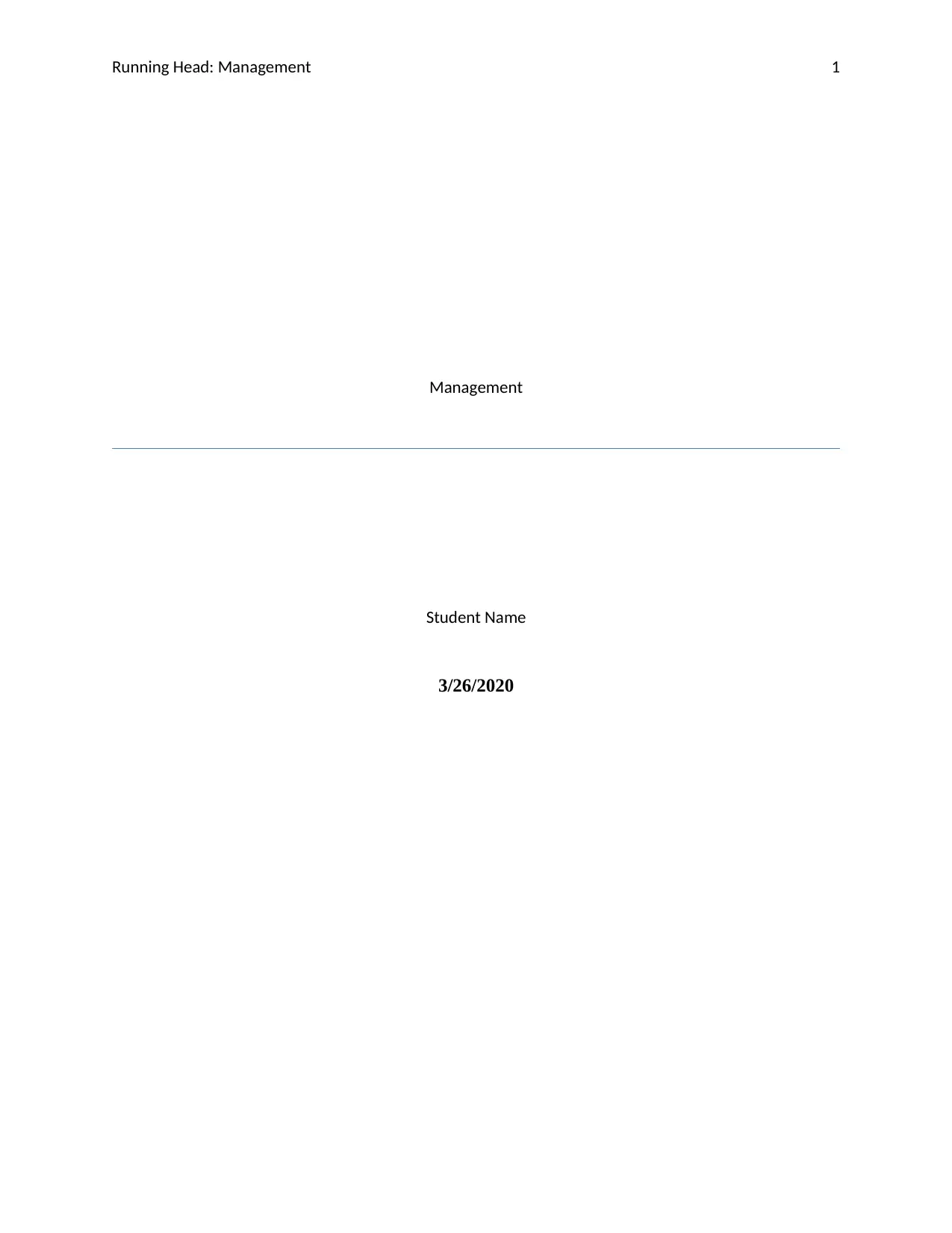
Running Head: Management 1
Management
Student Name
3/26/2020
Management
Student Name
3/26/2020
Paraphrase This Document
Need a fresh take? Get an instant paraphrase of this document with our AI Paraphraser
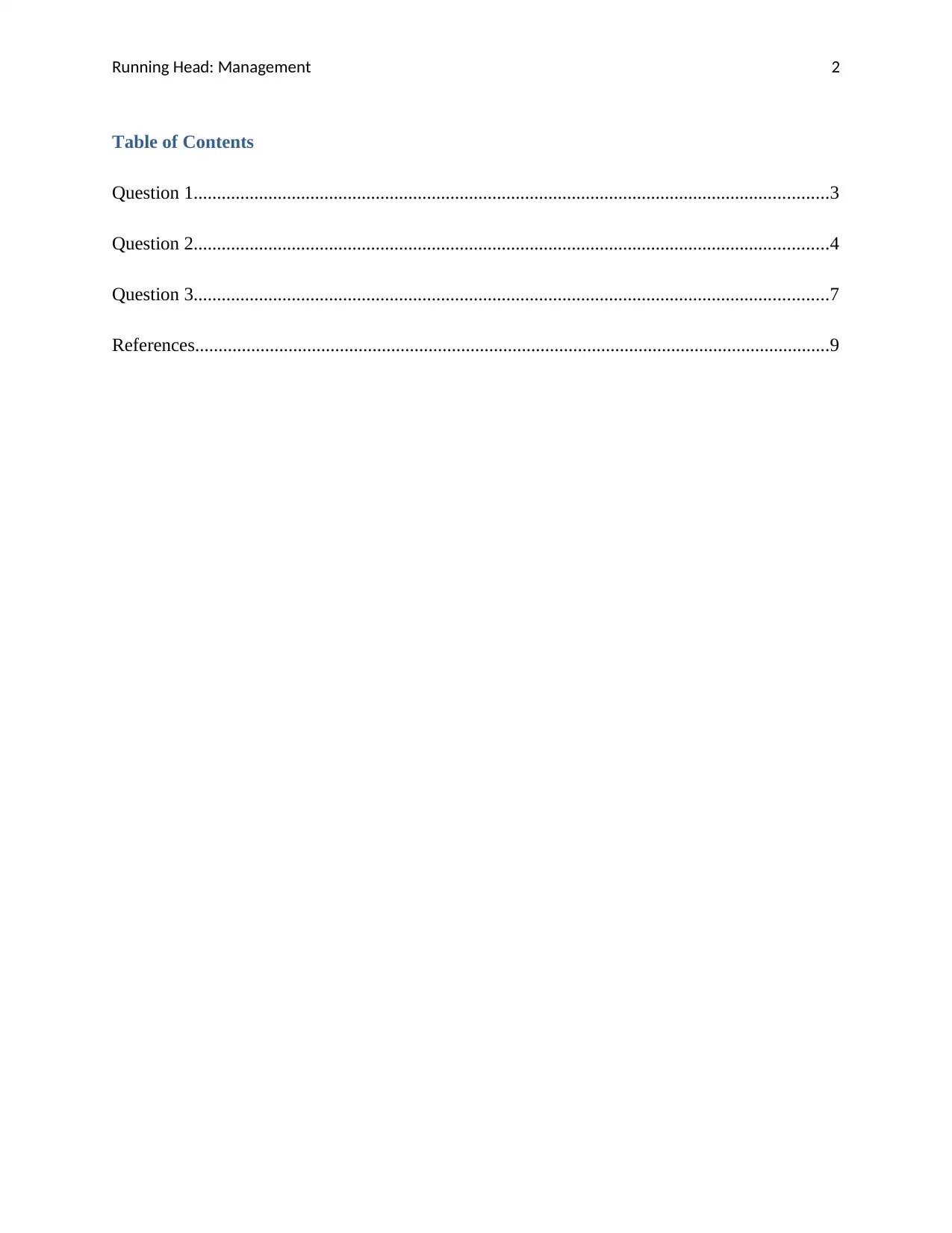
Running Head: Management 2
Table of Contents
Question 1........................................................................................................................................3
Question 2........................................................................................................................................4
Question 3........................................................................................................................................7
References........................................................................................................................................9
Table of Contents
Question 1........................................................................................................................................3
Question 2........................................................................................................................................4
Question 3........................................................................................................................................7
References........................................................................................................................................9
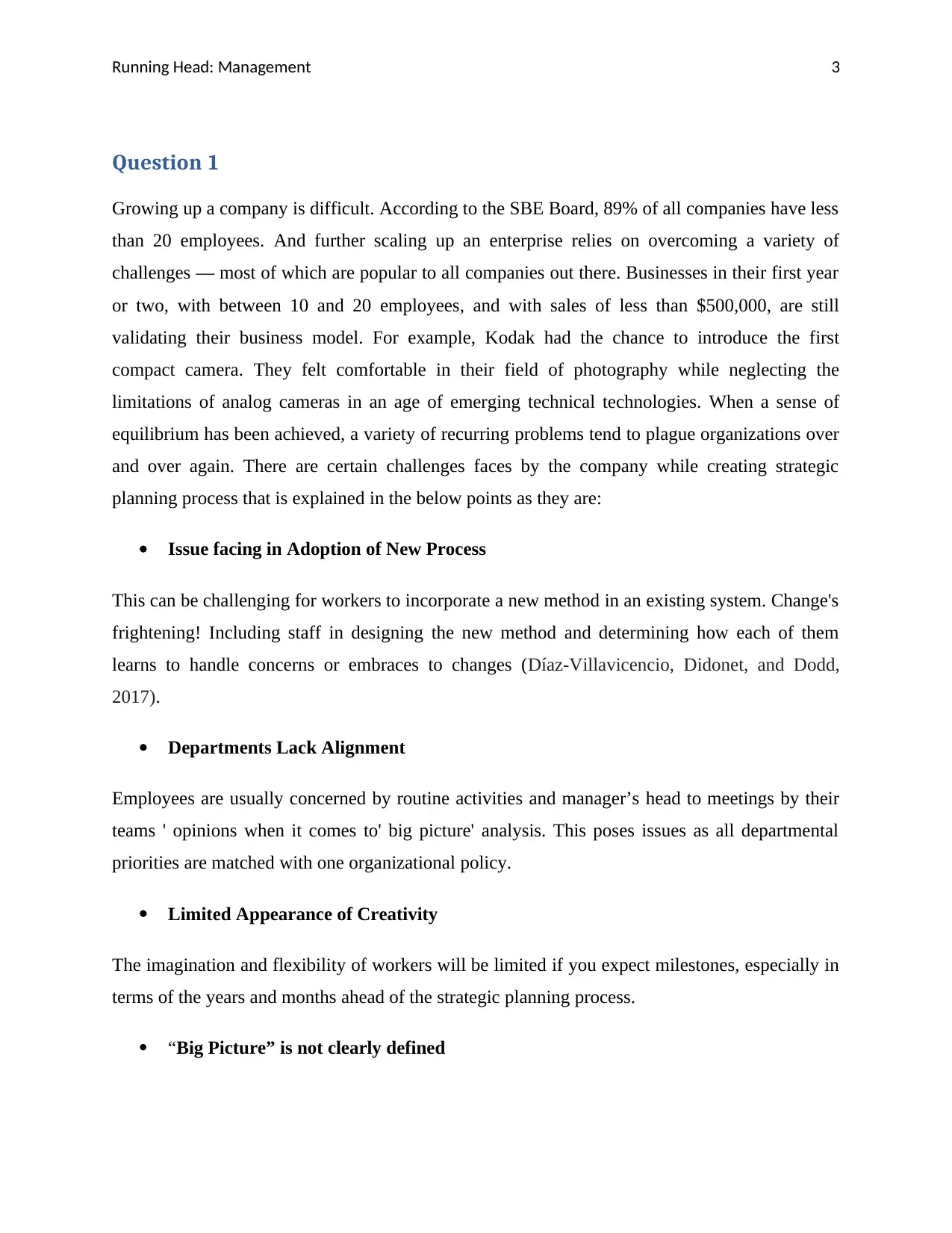
Running Head: Management 3
Question 1
Growing up a company is difficult. According to the SBE Board, 89% of all companies have less
than 20 employees. And further scaling up an enterprise relies on overcoming a variety of
challenges — most of which are popular to all companies out there. Businesses in their first year
or two, with between 10 and 20 employees, and with sales of less than $500,000, are still
validating their business model. For example, Kodak had the chance to introduce the first
compact camera. They felt comfortable in their field of photography while neglecting the
limitations of analog cameras in an age of emerging technical technologies. When a sense of
equilibrium has been achieved, a variety of recurring problems tend to plague organizations over
and over again. There are certain challenges faces by the company while creating strategic
planning process that is explained in the below points as they are:
Issue facing in Adoption of New Process
This can be challenging for workers to incorporate a new method in an existing system. Change's
frightening! Including staff in designing the new method and determining how each of them
learns to handle concerns or embraces to changes (Díaz-Villavicencio, Didonet, and Dodd,
2017).
Departments Lack Alignment
Employees are usually concerned by routine activities and manager’s head to meetings by their
teams ' opinions when it comes to' big picture' analysis. This poses issues as all departmental
priorities are matched with one organizational policy.
Limited Appearance of Creativity
The imagination and flexibility of workers will be limited if you expect milestones, especially in
terms of the years and months ahead of the strategic planning process.
“Big Picture” is not clearly defined
Question 1
Growing up a company is difficult. According to the SBE Board, 89% of all companies have less
than 20 employees. And further scaling up an enterprise relies on overcoming a variety of
challenges — most of which are popular to all companies out there. Businesses in their first year
or two, with between 10 and 20 employees, and with sales of less than $500,000, are still
validating their business model. For example, Kodak had the chance to introduce the first
compact camera. They felt comfortable in their field of photography while neglecting the
limitations of analog cameras in an age of emerging technical technologies. When a sense of
equilibrium has been achieved, a variety of recurring problems tend to plague organizations over
and over again. There are certain challenges faces by the company while creating strategic
planning process that is explained in the below points as they are:
Issue facing in Adoption of New Process
This can be challenging for workers to incorporate a new method in an existing system. Change's
frightening! Including staff in designing the new method and determining how each of them
learns to handle concerns or embraces to changes (Díaz-Villavicencio, Didonet, and Dodd,
2017).
Departments Lack Alignment
Employees are usually concerned by routine activities and manager’s head to meetings by their
teams ' opinions when it comes to' big picture' analysis. This poses issues as all departmental
priorities are matched with one organizational policy.
Limited Appearance of Creativity
The imagination and flexibility of workers will be limited if you expect milestones, especially in
terms of the years and months ahead of the strategic planning process.
“Big Picture” is not clearly defined
⊘ This is a preview!⊘
Do you want full access?
Subscribe today to unlock all pages.

Trusted by 1+ million students worldwide
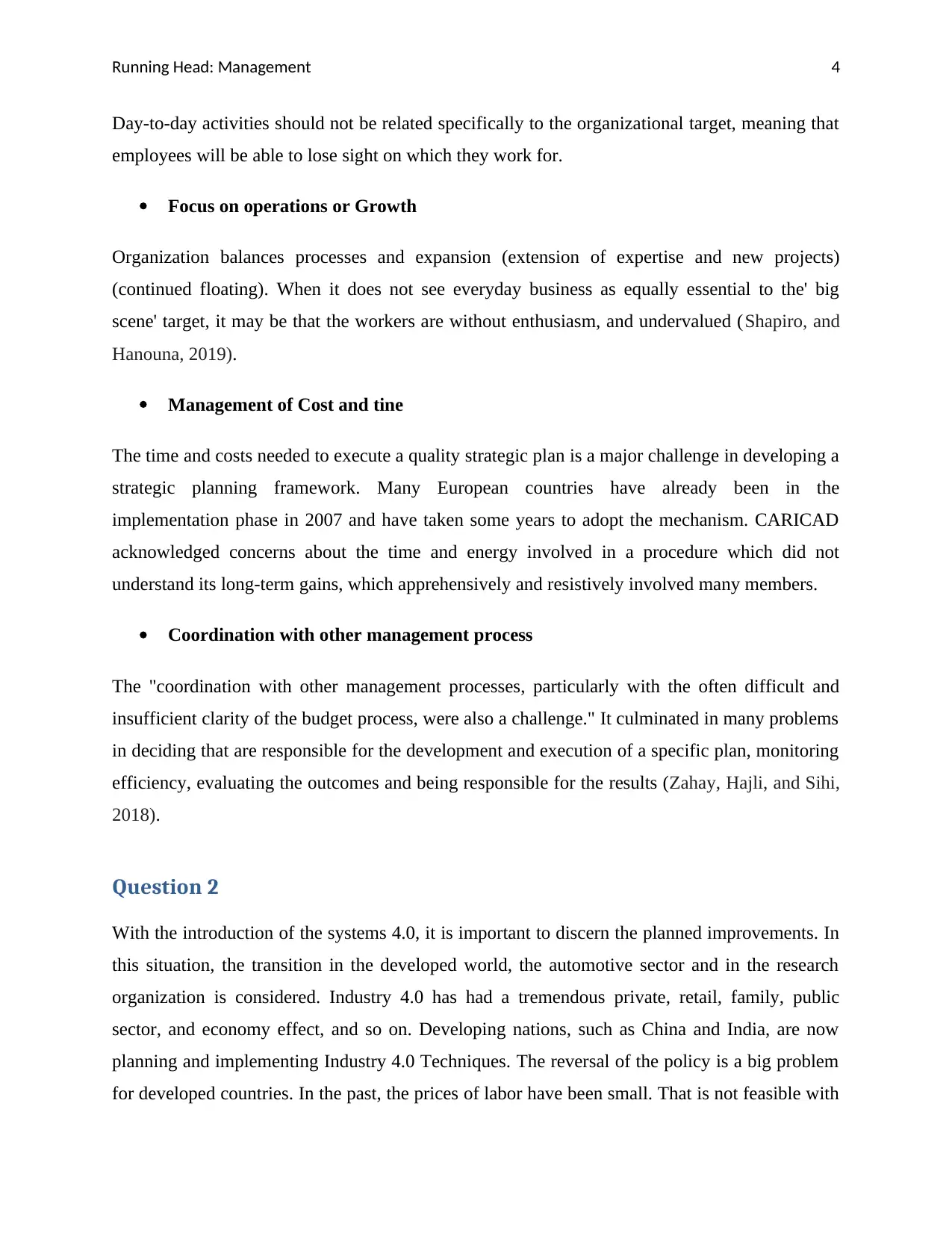
Running Head: Management 4
Day-to-day activities should not be related specifically to the organizational target, meaning that
employees will be able to lose sight on which they work for.
Focus on operations or Growth
Organization balances processes and expansion (extension of expertise and new projects)
(continued floating). When it does not see everyday business as equally essential to the' big
scene' target, it may be that the workers are without enthusiasm, and undervalued (Shapiro, and
Hanouna, 2019).
Management of Cost and tine
The time and costs needed to execute a quality strategic plan is a major challenge in developing a
strategic planning framework. Many European countries have already been in the
implementation phase in 2007 and have taken some years to adopt the mechanism. CARICAD
acknowledged concerns about the time and energy involved in a procedure which did not
understand its long-term gains, which apprehensively and resistively involved many members.
Coordination with other management process
The "coordination with other management processes, particularly with the often difficult and
insufficient clarity of the budget process, were also a challenge." It culminated in many problems
in deciding that are responsible for the development and execution of a specific plan, monitoring
efficiency, evaluating the outcomes and being responsible for the results (Zahay, Hajli, and Sihi,
2018).
Question 2
With the introduction of the systems 4.0, it is important to discern the planned improvements. In
this situation, the transition in the developed world, the automotive sector and in the research
organization is considered. Industry 4.0 has had a tremendous private, retail, family, public
sector, and economy effect, and so on. Developing nations, such as China and India, are now
planning and implementing Industry 4.0 Techniques. The reversal of the policy is a big problem
for developed countries. In the past, the prices of labor have been small. That is not feasible with
Day-to-day activities should not be related specifically to the organizational target, meaning that
employees will be able to lose sight on which they work for.
Focus on operations or Growth
Organization balances processes and expansion (extension of expertise and new projects)
(continued floating). When it does not see everyday business as equally essential to the' big
scene' target, it may be that the workers are without enthusiasm, and undervalued (Shapiro, and
Hanouna, 2019).
Management of Cost and tine
The time and costs needed to execute a quality strategic plan is a major challenge in developing a
strategic planning framework. Many European countries have already been in the
implementation phase in 2007 and have taken some years to adopt the mechanism. CARICAD
acknowledged concerns about the time and energy involved in a procedure which did not
understand its long-term gains, which apprehensively and resistively involved many members.
Coordination with other management process
The "coordination with other management processes, particularly with the often difficult and
insufficient clarity of the budget process, were also a challenge." It culminated in many problems
in deciding that are responsible for the development and execution of a specific plan, monitoring
efficiency, evaluating the outcomes and being responsible for the results (Zahay, Hajli, and Sihi,
2018).
Question 2
With the introduction of the systems 4.0, it is important to discern the planned improvements. In
this situation, the transition in the developed world, the automotive sector and in the research
organization is considered. Industry 4.0 has had a tremendous private, retail, family, public
sector, and economy effect, and so on. Developing nations, such as China and India, are now
planning and implementing Industry 4.0 Techniques. The reversal of the policy is a big problem
for developed countries. In the past, the prices of labor have been small. That is not feasible with
Paraphrase This Document
Need a fresh take? Get an instant paraphrase of this document with our AI Paraphraser
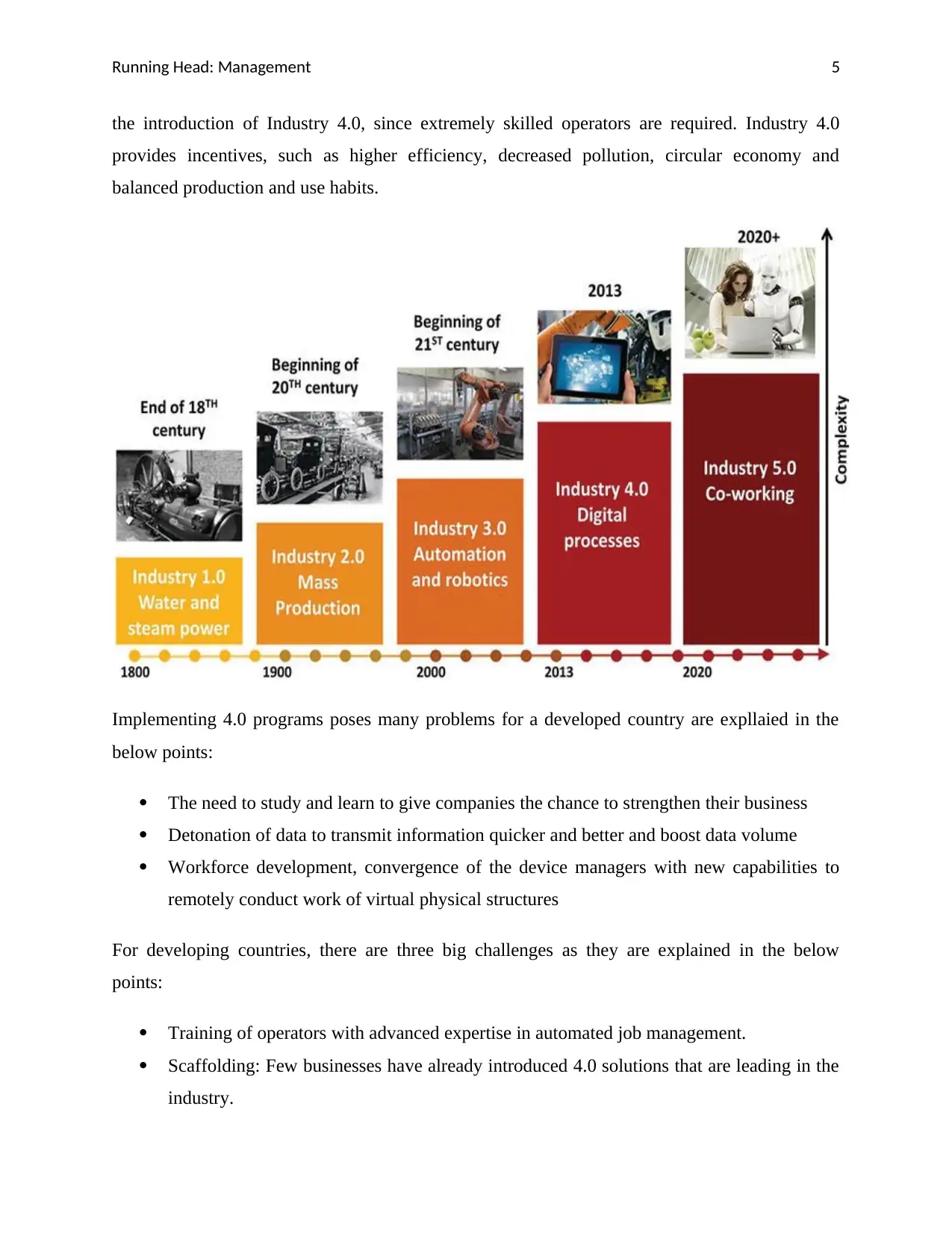
Running Head: Management 5
the introduction of Industry 4.0, since extremely skilled operators are required. Industry 4.0
provides incentives, such as higher efficiency, decreased pollution, circular economy and
balanced production and use habits.
Implementing 4.0 programs poses many problems for a developed country are expllaied in the
below points:
The need to study and learn to give companies the chance to strengthen their business
Detonation of data to transmit information quicker and better and boost data volume
Workforce development, convergence of the device managers with new capabilities to
remotely conduct work of virtual physical structures
For developing countries, there are three big challenges as they are explained in the below
points:
Training of operators with advanced expertise in automated job management.
Scaffolding: Few businesses have already introduced 4.0 solutions that are leading in the
industry.
the introduction of Industry 4.0, since extremely skilled operators are required. Industry 4.0
provides incentives, such as higher efficiency, decreased pollution, circular economy and
balanced production and use habits.
Implementing 4.0 programs poses many problems for a developed country are expllaied in the
below points:
The need to study and learn to give companies the chance to strengthen their business
Detonation of data to transmit information quicker and better and boost data volume
Workforce development, convergence of the device managers with new capabilities to
remotely conduct work of virtual physical structures
For developing countries, there are three big challenges as they are explained in the below
points:
Training of operators with advanced expertise in automated job management.
Scaffolding: Few businesses have already introduced 4.0 solutions that are leading in the
industry.
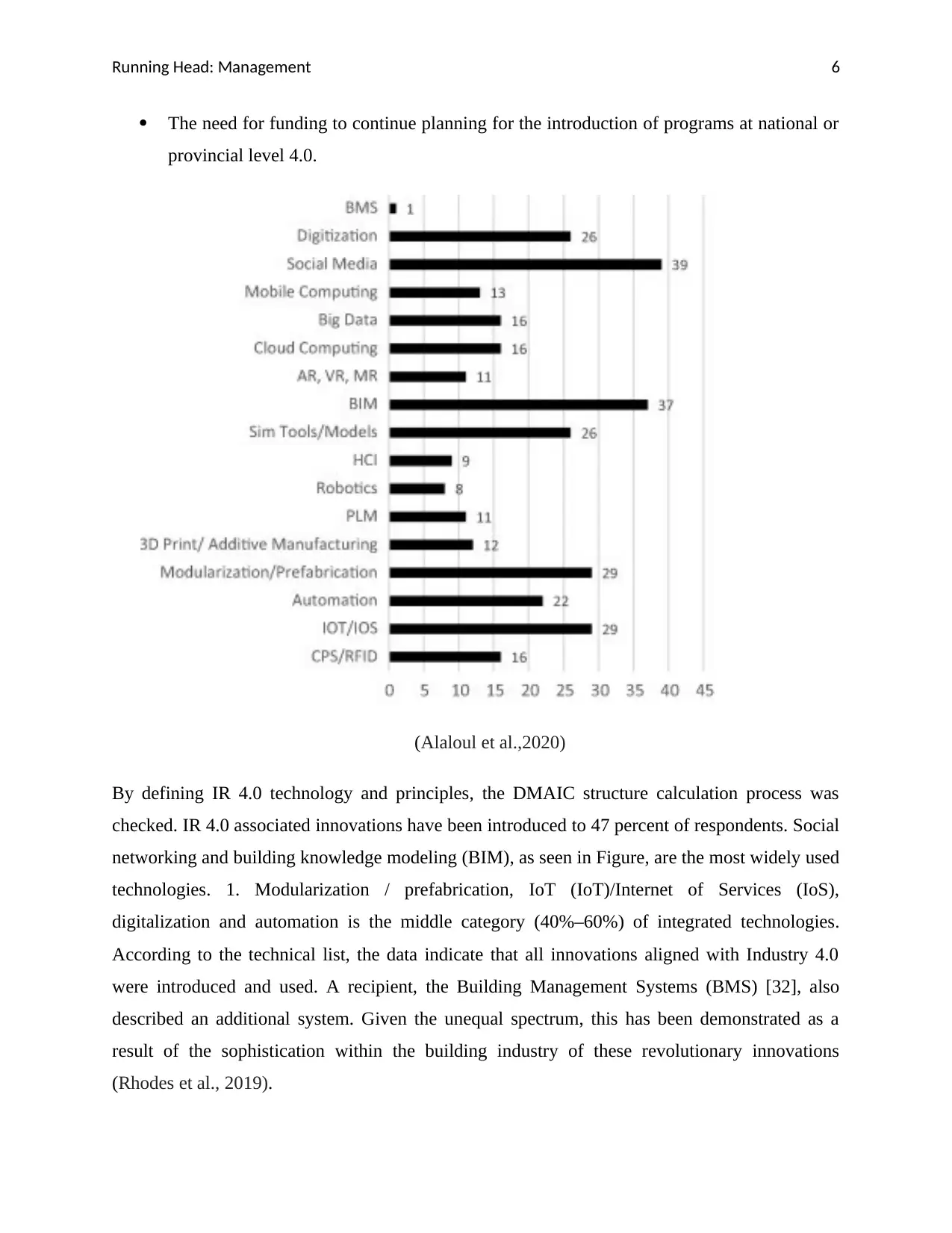
Running Head: Management 6
The need for funding to continue planning for the introduction of programs at national or
provincial level 4.0.
(Alaloul et al.,2020)
By defining IR 4.0 technology and principles, the DMAIC structure calculation process was
checked. IR 4.0 associated innovations have been introduced to 47 percent of respondents. Social
networking and building knowledge modeling (BIM), as seen in Figure, are the most widely used
technologies. 1. Modularization / prefabrication, IoT (IoT)/Internet of Services (IoS),
digitalization and automation is the middle category (40%–60%) of integrated technologies.
According to the technical list, the data indicate that all innovations aligned with Industry 4.0
were introduced and used. A recipient, the Building Management Systems (BMS) [32], also
described an additional system. Given the unequal spectrum, this has been demonstrated as a
result of the sophistication within the building industry of these revolutionary innovations
(Rhodes et al., 2019).
The need for funding to continue planning for the introduction of programs at national or
provincial level 4.0.
(Alaloul et al.,2020)
By defining IR 4.0 technology and principles, the DMAIC structure calculation process was
checked. IR 4.0 associated innovations have been introduced to 47 percent of respondents. Social
networking and building knowledge modeling (BIM), as seen in Figure, are the most widely used
technologies. 1. Modularization / prefabrication, IoT (IoT)/Internet of Services (IoS),
digitalization and automation is the middle category (40%–60%) of integrated technologies.
According to the technical list, the data indicate that all innovations aligned with Industry 4.0
were introduced and used. A recipient, the Building Management Systems (BMS) [32], also
described an additional system. Given the unequal spectrum, this has been demonstrated as a
result of the sophistication within the building industry of these revolutionary innovations
(Rhodes et al., 2019).
⊘ This is a preview!⊘
Do you want full access?
Subscribe today to unlock all pages.

Trusted by 1+ million students worldwide
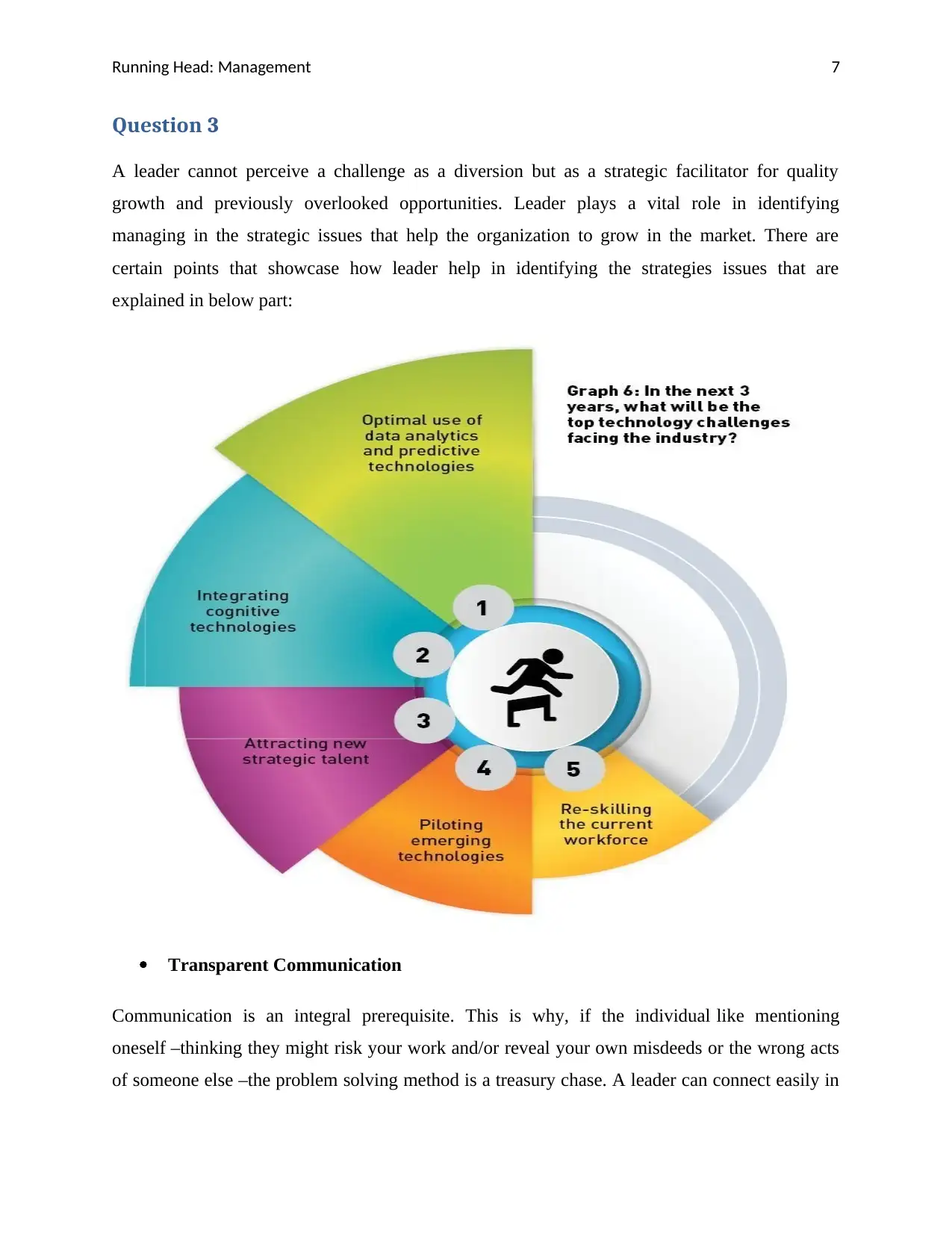
Running Head: Management 7
Question 3
A leader cannot perceive a challenge as a diversion but as a strategic facilitator for quality
growth and previously overlooked opportunities. Leader plays a vital role in identifying
managing in the strategic issues that help the organization to grow in the market. There are
certain points that showcase how leader help in identifying the strategies issues that are
explained in below part:
Transparent Communication
Communication is an integral prerequisite. This is why, if the individual like mentioning
oneself –thinking they might risk your work and/or reveal your own misdeeds or the wrong acts
of someone else –the problem solving method is a treasury chase. A leader can connect easily in
Question 3
A leader cannot perceive a challenge as a diversion but as a strategic facilitator for quality
growth and previously overlooked opportunities. Leader plays a vital role in identifying
managing in the strategic issues that help the organization to grow in the market. There are
certain points that showcase how leader help in identifying the strategies issues that are
explained in below part:
Transparent Communication
Communication is an integral prerequisite. This is why, if the individual like mentioning
oneself –thinking they might risk your work and/or reveal your own misdeeds or the wrong acts
of someone else –the problem solving method is a treasury chase. A leader can connect easily in
Paraphrase This Document
Need a fresh take? Get an instant paraphrase of this document with our AI Paraphraser
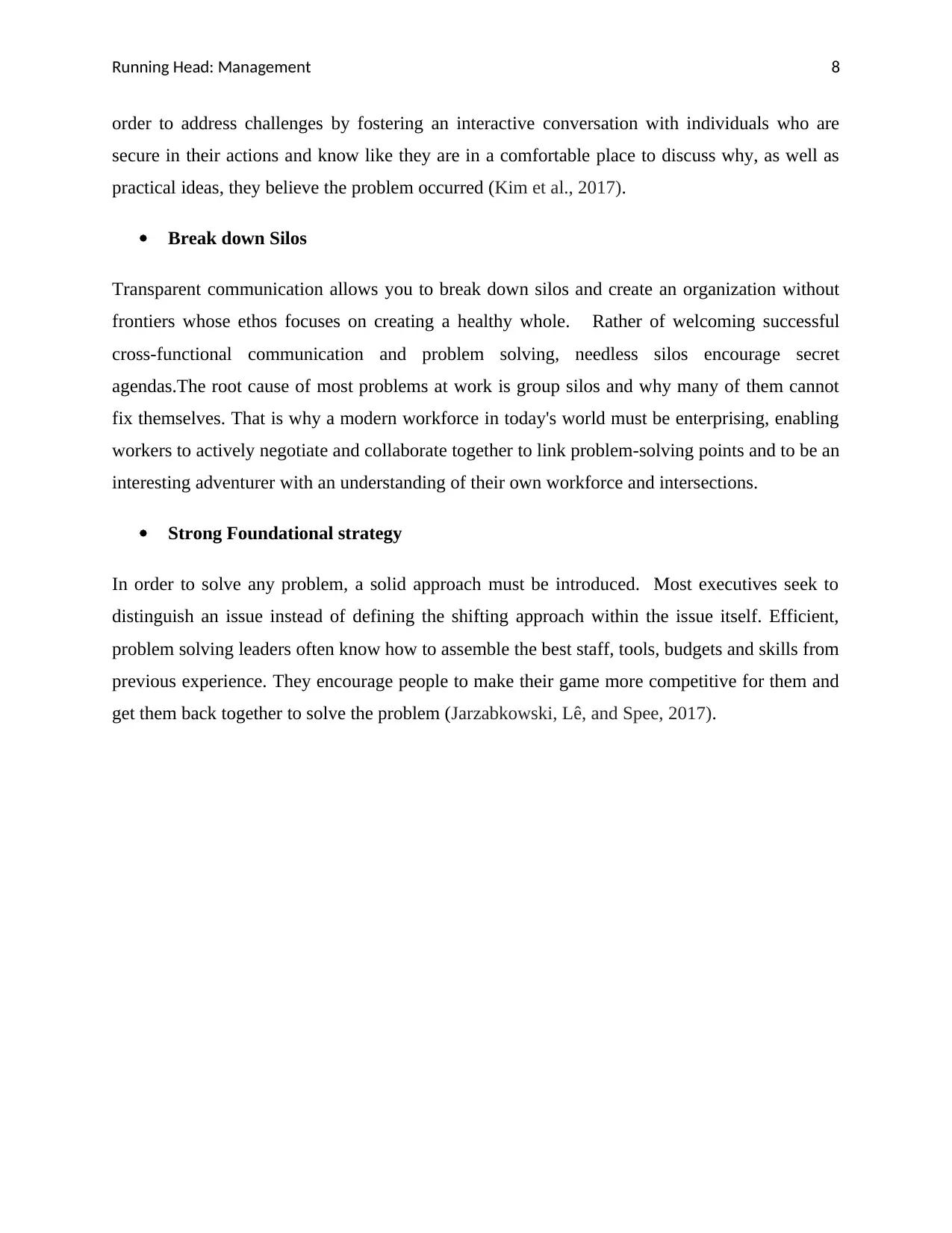
Running Head: Management 8
order to address challenges by fostering an interactive conversation with individuals who are
secure in their actions and know like they are in a comfortable place to discuss why, as well as
practical ideas, they believe the problem occurred (Kim et al., 2017).
Break down Silos
Transparent communication allows you to break down silos and create an organization without
frontiers whose ethos focuses on creating a healthy whole. Rather of welcoming successful
cross-functional communication and problem solving, needless silos encourage secret
agendas.The root cause of most problems at work is group silos and why many of them cannot
fix themselves. That is why a modern workforce in today's world must be enterprising, enabling
workers to actively negotiate and collaborate together to link problem-solving points and to be an
interesting adventurer with an understanding of their own workforce and intersections.
Strong Foundational strategy
In order to solve any problem, a solid approach must be introduced. Most executives seek to
distinguish an issue instead of defining the shifting approach within the issue itself. Efficient,
problem solving leaders often know how to assemble the best staff, tools, budgets and skills from
previous experience. They encourage people to make their game more competitive for them and
get them back together to solve the problem (Jarzabkowski, Lê, and Spee, 2017).
order to address challenges by fostering an interactive conversation with individuals who are
secure in their actions and know like they are in a comfortable place to discuss why, as well as
practical ideas, they believe the problem occurred (Kim et al., 2017).
Break down Silos
Transparent communication allows you to break down silos and create an organization without
frontiers whose ethos focuses on creating a healthy whole. Rather of welcoming successful
cross-functional communication and problem solving, needless silos encourage secret
agendas.The root cause of most problems at work is group silos and why many of them cannot
fix themselves. That is why a modern workforce in today's world must be enterprising, enabling
workers to actively negotiate and collaborate together to link problem-solving points and to be an
interesting adventurer with an understanding of their own workforce and intersections.
Strong Foundational strategy
In order to solve any problem, a solid approach must be introduced. Most executives seek to
distinguish an issue instead of defining the shifting approach within the issue itself. Efficient,
problem solving leaders often know how to assemble the best staff, tools, budgets and skills from
previous experience. They encourage people to make their game more competitive for them and
get them back together to solve the problem (Jarzabkowski, Lê, and Spee, 2017).
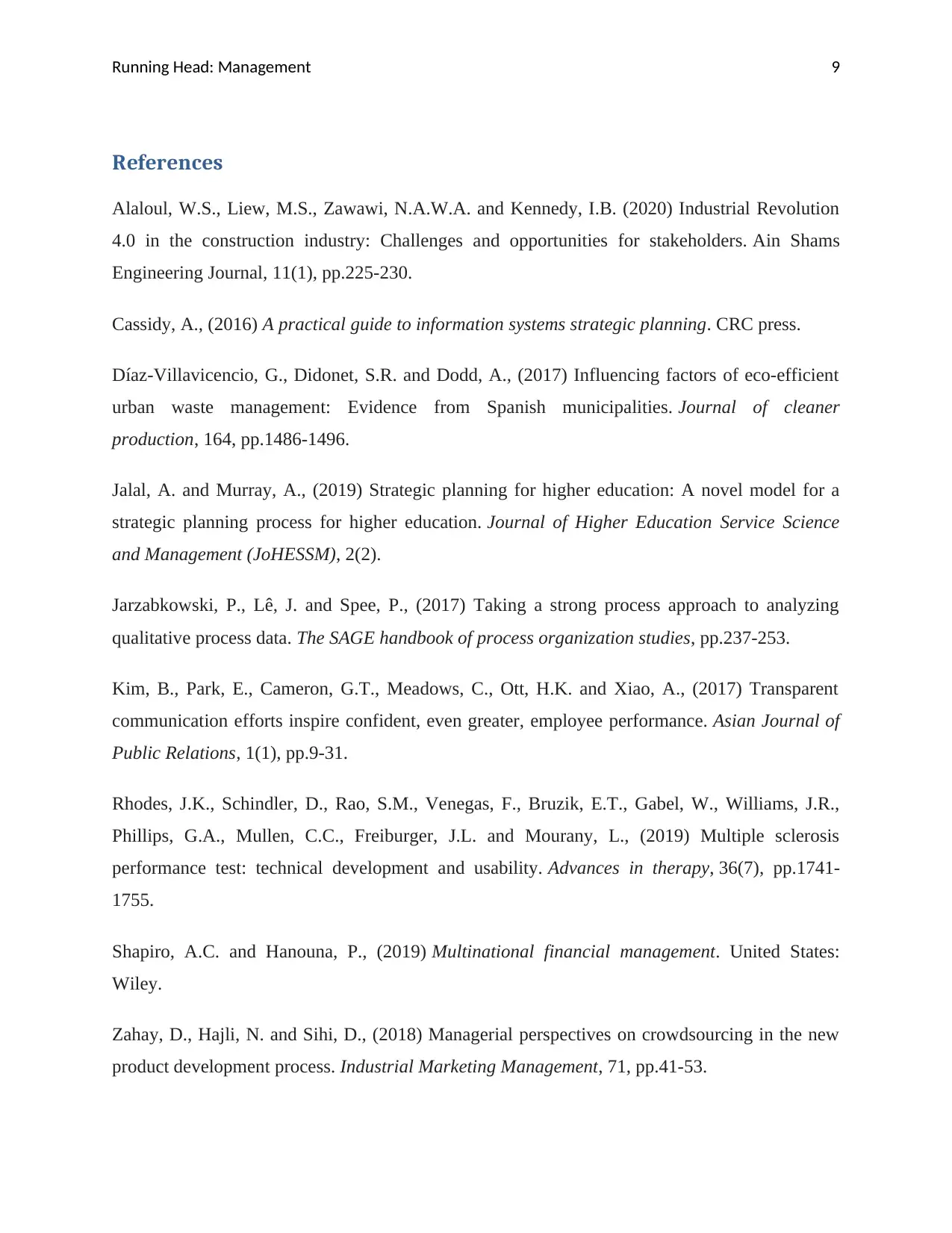
Running Head: Management 9
References
Alaloul, W.S., Liew, M.S., Zawawi, N.A.W.A. and Kennedy, I.B. (2020) Industrial Revolution
4.0 in the construction industry: Challenges and opportunities for stakeholders. Ain Shams
Engineering Journal, 11(1), pp.225-230.
Cassidy, A., (2016) A practical guide to information systems strategic planning. CRC press.
Díaz-Villavicencio, G., Didonet, S.R. and Dodd, A., (2017) Influencing factors of eco-efficient
urban waste management: Evidence from Spanish municipalities. Journal of cleaner
production, 164, pp.1486-1496.
Jalal, A. and Murray, A., (2019) Strategic planning for higher education: A novel model for a
strategic planning process for higher education. Journal of Higher Education Service Science
and Management (JoHESSM), 2(2).
Jarzabkowski, P., Lê, J. and Spee, P., (2017) Taking a strong process approach to analyzing
qualitative process data. The SAGE handbook of process organization studies, pp.237-253.
Kim, B., Park, E., Cameron, G.T., Meadows, C., Ott, H.K. and Xiao, A., (2017) Transparent
communication efforts inspire confident, even greater, employee performance. Asian Journal of
Public Relations, 1(1), pp.9-31.
Rhodes, J.K., Schindler, D., Rao, S.M., Venegas, F., Bruzik, E.T., Gabel, W., Williams, J.R.,
Phillips, G.A., Mullen, C.C., Freiburger, J.L. and Mourany, L., (2019) Multiple sclerosis
performance test: technical development and usability. Advances in therapy, 36(7), pp.1741-
1755.
Shapiro, A.C. and Hanouna, P., (2019) Multinational financial management. United States:
Wiley.
Zahay, D., Hajli, N. and Sihi, D., (2018) Managerial perspectives on crowdsourcing in the new
product development process. Industrial Marketing Management, 71, pp.41-53.
References
Alaloul, W.S., Liew, M.S., Zawawi, N.A.W.A. and Kennedy, I.B. (2020) Industrial Revolution
4.0 in the construction industry: Challenges and opportunities for stakeholders. Ain Shams
Engineering Journal, 11(1), pp.225-230.
Cassidy, A., (2016) A practical guide to information systems strategic planning. CRC press.
Díaz-Villavicencio, G., Didonet, S.R. and Dodd, A., (2017) Influencing factors of eco-efficient
urban waste management: Evidence from Spanish municipalities. Journal of cleaner
production, 164, pp.1486-1496.
Jalal, A. and Murray, A., (2019) Strategic planning for higher education: A novel model for a
strategic planning process for higher education. Journal of Higher Education Service Science
and Management (JoHESSM), 2(2).
Jarzabkowski, P., Lê, J. and Spee, P., (2017) Taking a strong process approach to analyzing
qualitative process data. The SAGE handbook of process organization studies, pp.237-253.
Kim, B., Park, E., Cameron, G.T., Meadows, C., Ott, H.K. and Xiao, A., (2017) Transparent
communication efforts inspire confident, even greater, employee performance. Asian Journal of
Public Relations, 1(1), pp.9-31.
Rhodes, J.K., Schindler, D., Rao, S.M., Venegas, F., Bruzik, E.T., Gabel, W., Williams, J.R.,
Phillips, G.A., Mullen, C.C., Freiburger, J.L. and Mourany, L., (2019) Multiple sclerosis
performance test: technical development and usability. Advances in therapy, 36(7), pp.1741-
1755.
Shapiro, A.C. and Hanouna, P., (2019) Multinational financial management. United States:
Wiley.
Zahay, D., Hajli, N. and Sihi, D., (2018) Managerial perspectives on crowdsourcing in the new
product development process. Industrial Marketing Management, 71, pp.41-53.
⊘ This is a preview!⊘
Do you want full access?
Subscribe today to unlock all pages.

Trusted by 1+ million students worldwide
1 out of 9
Related Documents
Your All-in-One AI-Powered Toolkit for Academic Success.
+13062052269
info@desklib.com
Available 24*7 on WhatsApp / Email
![[object Object]](/_next/static/media/star-bottom.7253800d.svg)
Unlock your academic potential
Copyright © 2020–2025 A2Z Services. All Rights Reserved. Developed and managed by ZUCOL.





![Introduction to People Management: CW1 Report - [University Name]](/_next/image/?url=https%3A%2F%2Fdesklib.com%2Fmedia%2Fimages%2Fsj%2F46a65675ab244f269459d3765dd74c4f.jpg&w=256&q=75)